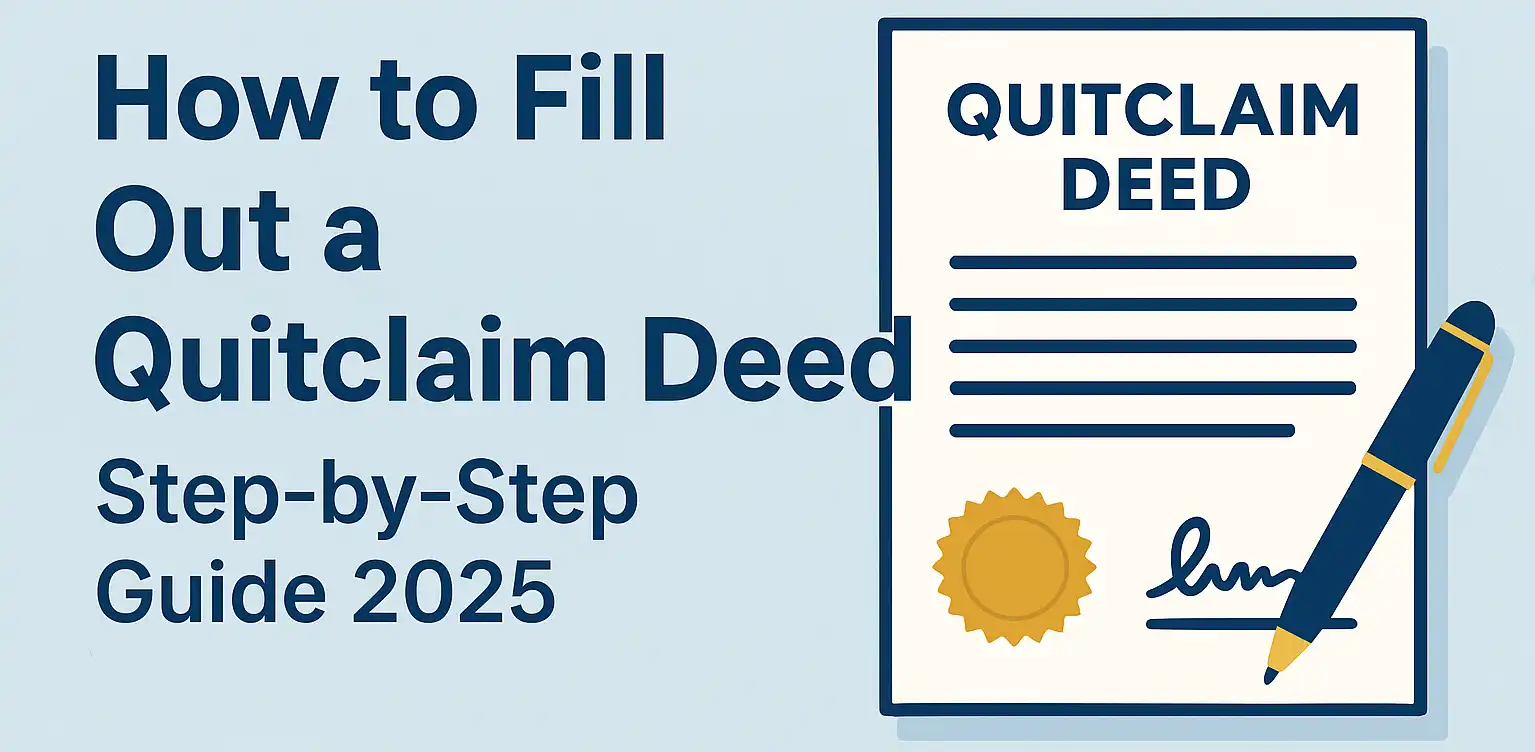
Filling out a quitclaim deed correctly is crucial for a valid property transfer. Unlike other legal documents, quitclaim deeds follow specific formatting requirements that vary by state, and even small errors can invalidate the transfer or create future title problems.
This comprehensive guide walks you through each section of a quitclaim deed, explains what information is required, and provides tips to avoid common mistakes. Before proceeding, ensure you understand what a quitclaim deed is and when it’s appropriate to use one.
Before You Begin: Essential Preparation
Gather Required Information
Grantor Information (Person Transferring Property):
- Full legal name as it appears on current deed
- Current mailing address
- Marital status (required in many states)
Grantee Information (Person Receiving Property):
- Full legal name (exactly as you want it on the new deed)
- Current mailing address
- Marital status and how title will be held
Property Information:
- Complete legal description from current deed or tax records
- Property address (street address)
- Assessor’s parcel number (APN) or tax ID number
Financial Information:
- Consideration amount (can be nominal like $1)
- Any existing mortgage information
Obtain Current Deed Information
Before filling out your quitclaim deed, locate the current deed to ensure accuracy:
- County recorder’s office (online or in person)
- Title company records
- Original deed from when you purchased the property
- Property tax records for legal description verification
Step-by-Step Instructions
Step 1: Document Header and Title
Most quitclaim deed forms begin with a title section:
Document Title: “Quitclaim Deed” (some states use “Quit Claim Deed”)
Recording Information Box: Leave blank – the county recorder fills this section when the deed is recorded.
Return Address: Enter the address where the recorded deed should be mailed after filing. This is typically the grantee’s address.
Step 2: Grantor Information Section
Full Legal Name: Enter the grantor’s name exactly as it appears on the current deed. Common mistakes include:
- Using nicknames instead of legal names
- Incorrect spelling or different name variations
- Omitting middle names or initials that appear on the current deed
Mailing Address: Provide the grantor’s current mailing address including city, state, and ZIP code.
Marital Status: Many states require disclosure of marital status. Options typically include:
- Single
- Married
- Divorced
- Widowed
Step 3: Grantee Information Section
Full Legal Name: Enter the grantee’s name exactly as they want it to appear on the new deed. Consider:
- Using full legal names rather than nicknames
- Consistency with other legal documents
- Future identification requirements
Mailing Address: Provide the grantee’s current mailing address.
Ownership Type: If multiple grantees, specify how they will hold title:
- Joint tenants with rights of survivorship (JTWROS)
- Tenants in common
- Community property (in community property states)
- Tenants by the entirety (for married couples in some states)
Step 4: Property Description
This is the most critical section requiring exact accuracy:
Legal Description: Copy the complete legal description from the current deed word-for-word. Legal descriptions typically include:
- Metes and bounds (directions and distances)
- Lot and block numbers (subdivision references)
- Government survey descriptions (township, range, section)
Common Legal Description Formats:
Subdivision Property: “Lot 12, Block 3, Maple Grove Subdivision, according to the plat thereof recorded in Plat Book 45, Page 67, Official Records of [County Name] County, [State].”
Metes and Bounds: “Beginning at a point on the north line of Oak Street, 150 feet west of the intersection of Oak Street and First Avenue; thence north 100 feet; thence west 50 feet; thence south 100 feet to the north line of Oak Street; thence east along said north line 50 feet to the point of beginning.”
Street Address: Include the property’s street address for identification purposes, though this is not the legal description.
Assessor’s Parcel Number: Include the APN or tax ID number if required by your state.
Step 5: Consideration
Consideration Amount: Enter the consideration (payment) for the transfer. Options include:
- Nominal consideration: “$1.00 and other good and valuable consideration”
- Actual consideration: The real amount paid (if any)
- Love and affection: For family transfers (if allowed by state law)
Tax Implications: The consideration amount may affect transfer taxes and gift tax reporting requirements.
Step 6: Granting Clause
The granting clause contains the operative language that transfers the property:
Standard Quitclaim Language: “The Grantor hereby quitclaims to the Grantee all interest, if any, in the above-described property.”
Alternative Phrasing: Some states use variations like:
- “Hereby grants, bargains, sells, and quitclaims”
- “Does hereby remise, release, and forever quitclaim”
Step 7: Warranties and Disclaimers
Quitclaim deeds typically include language clarifying the lack of warranties:
Standard Disclaimer: “This deed is given without warranty of title, express or implied. The Grantor makes no representations regarding the condition of title or the property.”
Step 8: Existing Mortgages and Liens
Mortgage Clause: Many forms include language about existing mortgages: “This conveyance is made subject to any existing mortgages, liens, or encumbrances of record.”
Important Note: Transferring property via quitclaim deed does not affect existing mortgage obligations. The original borrower remains liable for mortgage payments.
Step 9: Signature Requirements
Grantor Signature: Only the grantor (person transferring property) signs the quitclaim deed. Requirements include:
- Signature exactly as name appears on the deed
- Date of signing
- Printed name below signature
Spouse Signature: Many states require spouse signatures even if the spouse is not on the title, particularly in community property states.
Step 10: Notarization Requirements
Notary Requirements: Most states require notarization of the grantor’s signature. The notary section typically includes:
- Notary acknowledgment language
- Notary signature and seal
- Date of notarization
- Notary commission expiration
Identification Requirements: Bring valid government-issued photo identification to the notary appointment.
Step 11: Witness Requirements
Some states require witness signatures in addition to notarization:
- Number of witnesses (typically one or two)
- Witness qualifications (age, relationship restrictions)
- Witness information (printed names, addresses)
Common Mistakes to Avoid
Legal Description Errors
Never abbreviate or paraphrase the legal description. Copy it exactly from the current deed, including punctuation and capitalization.
Don’t use only the street address as the property description. Street addresses are not legally sufficient property descriptions.
Name Inconsistencies
Grantor names must match the current deed exactly. If your name has changed since you acquired the property, you may need additional documentation.
Grantee names should be precise and consistent with how the new owner wants to hold title.
Signature Issues
Electronic signatures are not accepted for real estate deeds in most states. Original ink signatures are required.
Incomplete notarization can invalidate the deed. Ensure all notary requirements are met.
Recording Delays
Record promptly after execution. Delays in recording can create title problems and priority issues.
Missing recording fees will prevent the deed from being recorded. Check current fee schedules with your county recorder.
State-Specific Considerations
Documentation Requirements
Transfer taxes: Many states and localities impose transfer taxes based on property value or sale price.
Disclosure forms: Some states require additional disclosure forms to accompany quitclaim deeds.
Recording requirements: Filing fees, format requirements, and recording procedures vary by state.
Form Variations
State-specific forms: While the basic elements are similar, each state has specific formatting and language requirements.
Local requirements: Counties may have additional requirements beyond state law.
After Completing the Form
Review and Verification
Double-check all information before signing:
- Names spelling and accuracy
- Legal description completeness
- Address accuracy
- Consideration amount
Have a second person review the completed deed for errors.
Recording Process
Submit to county recorder in the county where the property is located:
- Original signed deed
- Recording fees (varies by county)
- Transfer tax payments (if applicable)
- Additional required forms (varies by state)
Obtain copies of the recorded deed for your records.
Professional Assistance Recommendations
When to Seek Help
Consider professional assistance for:
- Complex property descriptions or title issues
- High-value property transfers
- Uncertain legal requirements in your state
- Multiple grantors or grantees
- Commercial or investment properties
Types of Professional Help
Real Estate Attorneys: For complex legal situations or when title issues exist.
Title Companies: Can prepare deeds and handle recording as part of title services.
Document Preparation Services: For straightforward transfers when you need forms prepared correctly.
Conclusion
Filling out a quitclaim deed requires attention to detail and accuracy in every section. While the process is straightforward, mistakes can have serious legal and financial consequences. Take time to gather accurate information, understand your state’s requirements, and consider professional assistance when dealing with complex situations or high-value properties.
Remember that quitclaim deeds provide no warranties or guarantees about title quality. Ensure this type of deed is appropriate for your situation before proceeding with the transfer.
Sources:
- American Bar Association. “Residential Real Estate FAQs.” ABA.org
- Internal Revenue Service. “Gift Tax.” IRS.gov
This guide provides general information about filling out quitclaim deeds and should not be considered legal advice. Property laws vary by state, and specific situations may require consultation with qualified legal professionals.


Leave a Reply